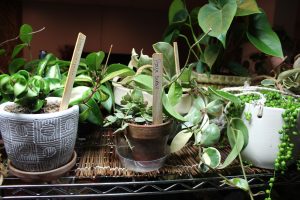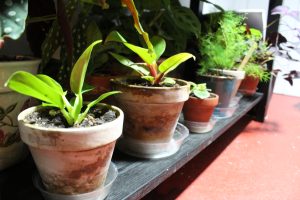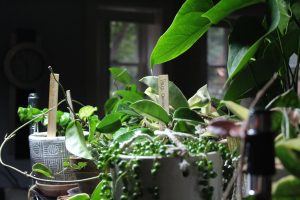By BRANDEN PACHECO
Standing at my potting bench with soiled hands I notice the dirt under my fingernails, mud running down my wrists in thick rivers. I gaze at the dozens of terrestrial and epiphytic plants, dulled shears, and roots spilt like guts on a butcher’s block. My eyes widen like the stunning night blooms of an epiphyllum.
What have I done?
Most 30-year-olds spend their downtime going on wine tastings and pub crawls. But not me.
 Instead, I’ve spent the last many months greenhouse-hopping and collecting houseplants. Evidently, just as there are folk with too many cats there, too, are us with too many plants.
Instead, I’ve spent the last many months greenhouse-hopping and collecting houseplants. Evidently, just as there are folk with too many cats there, too, are us with too many plants.
We daydream in kaleidoscopes of monstera fenestrations, variegated foliage and re-blooming African Violets rescued from discount racks. We covet south exposure even more so than realtors, and the perfect temperature of our homes is 80 degrees Fahrenheit with 60 percent humidity—and only because our plants love it.
My hobby started innocently, by casually stalking the florals in grocery stores. Over these months—fueled by Instagram envy and a shameless consumerism—I’ve amassed an unsustainable collection. Now, I am Plant Dad Extraordinaire to 137 houseplants, and I’m trying to learn as I go.
Except, I’m not a very good plant dad. I often forget their names. I compulsively drown them.
Our abode is a dark outfitted basement, so most of my plants have been living outside like neglected dogs, or hungrily huddled by the full-glass basement door reaching for the sun. If it weren’t for the summer heat and humidity, my fussy green friends would have struggled to photosynthesize.
Preparing for the Worst
 Our season’s trajectory doesn’t bode well: The Farmer’s Almanac predicts what it’s termed a “Polar Coaster” winter. So, if I’m to spare my tribe of tropicals certain winter devastation, I’ve got to furnish a suitable environment in my basement-prison. I’ve gotten myself into this mess. Now it’s time to take responsibility and not let my plants suffer in the cold.
Our season’s trajectory doesn’t bode well: The Farmer’s Almanac predicts what it’s termed a “Polar Coaster” winter. So, if I’m to spare my tribe of tropicals certain winter devastation, I’ve got to furnish a suitable environment in my basement-prison. I’ve gotten myself into this mess. Now it’s time to take responsibility and not let my plants suffer in the cold.
To be sure I’m taking the necessary precautions when moving my plants from outdoors to indoors, I speak with Barbara Conolly, owner of w. Her gardening and landscape work are elegantly balanced with science and art, and her hearty list of credentials is headlined by a graduate fellowship in Public Garden Leadership at Cornell University. Her advice is focused and thorough, and I know I’m talking to the right person.
Her immediate advice for bringing plants indoors is threefold: Prune excessive or unhealthy growth, and re-pot to a larger container if the roots are tightly bound.
Bring plants in before the nights dip below 50 degrees, as colder temperatures can trigger dormancy.
Treat for insects by washing with a mild dish soap. Oily mixtures will smother insects and their eggs.
 During this process, I notice a few of mine had become home to small spiders, but I let them be since they eat smaller, potentially harmful pests. My Senecio rowleyanus (string of pearls) was housing a small population of menacing aphids, so I doused the plant with organic Neem oil. It has an unpleasant, musky odor, so after a few days of regular treatments I let it air out for a few more. Barbara presses me to keep an eye out for the next 10 days as there’s still a chance for a second outbreak.
During this process, I notice a few of mine had become home to small spiders, but I let them be since they eat smaller, potentially harmful pests. My Senecio rowleyanus (string of pearls) was housing a small population of menacing aphids, so I doused the plant with organic Neem oil. It has an unpleasant, musky odor, so after a few days of regular treatments I let it air out for a few more. Barbara presses me to keep an eye out for the next 10 days as there’s still a chance for a second outbreak.
I tell her more about my situation, that my basement is mostly dark—except for the blazing pellet stove that heats the whole house. Incidentally, my plants will share the same room as this powerful furnace, and the potential for quickly drying soil and crispy leaves is just about guaranteed. Although the heat is good for most, the lack of humidity is not.
After browsing her paper on a scientific study on hydrangeas, I know she speaks the language of aspiring plant whisperers. I slowly work up the courage to use the Latin names of my beloved plants in conversation. My heart somersaults and I wonder: Is this one of the most intimate conversations I’ve had in months?
“Without a designated humidifier, will plants like Stromanthe sanguinea and Monstera adansonii necessarily fail?” I am so self-conscious I nearly slur the words. It’s thrilling to speak the scientific names of favorites with a live human, rather than practice my pronunciation in whispers in front of a screen, in the dark.
Her answer is a simple and emphatic “yes,” punctuated by her note that I am essentially bringing tropical plants into a dark desert environment. Conversely, she also reminds me to practice restraint: “The thing about indoor plants is being careful not to overwater.” She also says that terra cotta pots for indoor tropicals will soak up excess water better than plastic.
The Right Light
 More relaxed minds consider gardening a spiritual exercise, a way of cultivating a primal connection with nature and all its wonder. Not me. I’m too often haunted by nightmares filled with mealy bugs and root rot. Or finding the carcass of a forgotten phalaenopsis lodged between the couch and wall like a long-lost cat. Make no mistake: this project is motivated by anxiety. But I am able to relax a bit more when I reach out to the folks at Green Matters in Middleborough.
More relaxed minds consider gardening a spiritual exercise, a way of cultivating a primal connection with nature and all its wonder. Not me. I’m too often haunted by nightmares filled with mealy bugs and root rot. Or finding the carcass of a forgotten phalaenopsis lodged between the couch and wall like a long-lost cat. Make no mistake: this project is motivated by anxiety. But I am able to relax a bit more when I reach out to the folks at Green Matters in Middleborough.
Green Matters is home to dozens of lighting options: from LED or fluorescent, to single- and multi-bulb contraptions, I’ve no doubt they have the right equipment for any home-grower. And although their inventory caters to the expert, they also have options for simpler, table-top herb and vegetable gardens.
While some common houseplants like Epipremnum aureus (golden pothos) and Spathiphyllum wallisii (peace lily) can do just fine under the artificial lights in the office or at home, most in my collection are fussier and need the kind of full-spectrum light emitted from the Sun. I work with Riley Sepiel to devise a lighting strategy. With dual degrees in horticulture and business, his guidance is sound.
Riley asks about my collection and I tell him about some of my favorites: eight different hoyas, 14 begonias, and over a dozen orchids. Since these are not top canopy dwellers in their natural jungle habitats, they favor dappled and filtered light. He recommends a two-bulb Sun Blaze fluorescent fixture with 4,000 lumens. (Fun fact: whereas LED lights are directional, fluorescents are expansive.) According to Riley, this will be enough light to keep the plants happy without overwhelming them with more than they’re used to.
As this is my first foray in indoor growing on this scale, he tasks me with watching them carefully: yellowing or dropped leaves, stunted growth, and elongated stems will mean they need more light and I will have to install an additional fixture. He also recommends that I arrange my plants under the light in a way that mimics where they grow in the wild—from lower canopy to forest floor. It’s an ingenious idea that lends itself well to a basic metal shelving unit.
Riley’s cool confidence and lack of pretense put me at ease, and he reminds me that “Green Matters” will remain available to me should I have more questions down the road: “If you have a problem, we’ll have a solution.”
Now that the move and setup are complete, I rest easier. There is still much to monitor. But now, with the help of professionals, I am better prepared to manage my green friends—one plant at a time.

